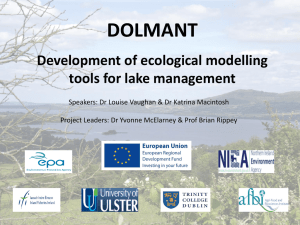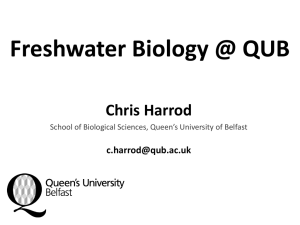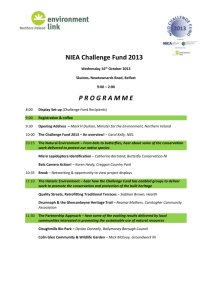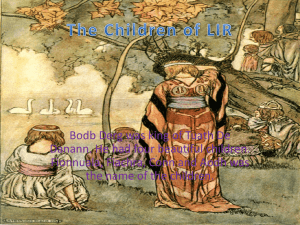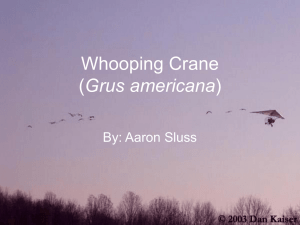4.9. Whooper Swan Species Action Plan
advertisement
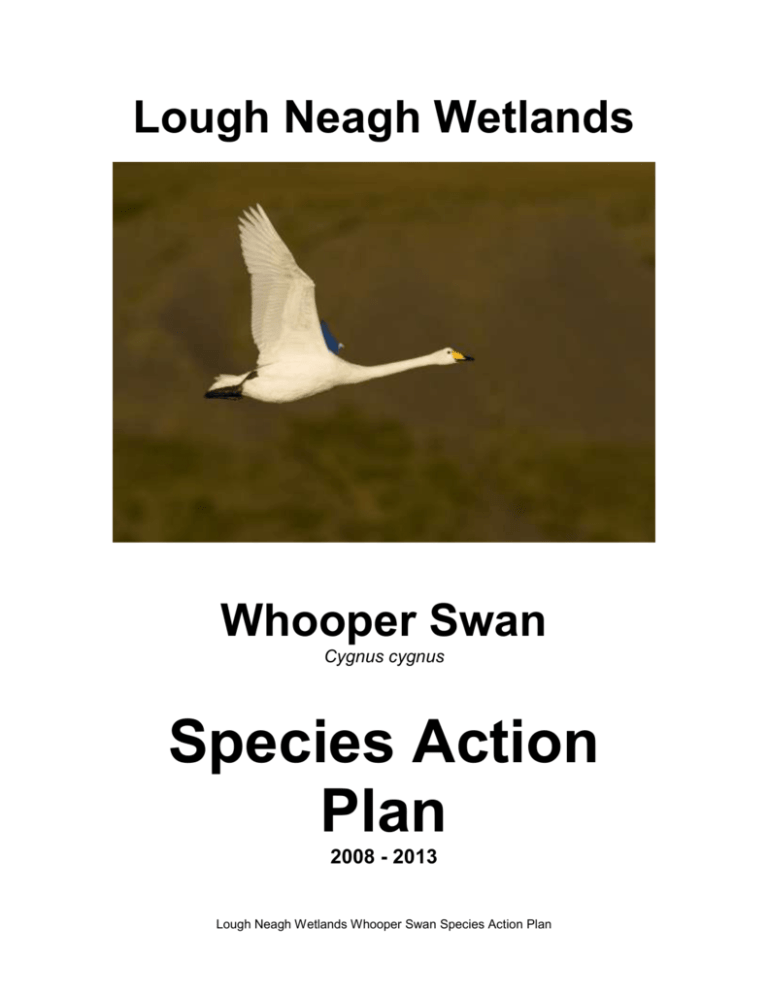
Lough Neagh Wetlands Whooper Swan Cygnus cygnus Species Action Plan 2008 - 2013 Lough Neagh Wetlands Whooper Swan Species Action Plan Whooper Swan in the Lough Neagh Wetlands Introduction Lough Neagh and Lough Beg wetland complex is ranked among the top five most important sites for whooper swans Cygnus cygnus in Britain and Ireland. The area has held considerable numbers since at least the early 1960’s. Little information is available on the overall numbers and distribution of the species before that time, although [450] were present at Lough Beg in December 1962. Counts made between 1964/65 and 1968/69 varied between 400 and 800 birds. In the early 1970’s, 600 birds were recorded in the area. Since the mid 1980’s, numbers have remained relatively stable, and Lough Neagh/Beg combined currently hold around 1,000 birds in mid winter, peaking in January and again in March. The birds congregate at freshwater roost sites on Lough Neagh and Lough Beg at night and then disperse to forage for food during the day. Although whooper swans also use the shallow waters around the edges of the two loughs, the principal feeding sites for the species are predominantly improved grassland habitats found nearby with at least 2350 hectares of farmland around Lough Neagh and Lough Beg thought to be used regularly each winter by whooper swans. The whooper swans found in Ireland are thought to exclusively originate from breeding grounds in Iceland, as only one ringed continental bird has ever been recorded here. Numbers visiting Ireland are thought to have increased since 1900 and have remained relatively stable since the mid 1950’s. As well as the Lough Neagh Wetlands, high numbers also occur in Northern Ireland at the Lough Foyle/River Foyle/Lough Swilly complex and at the Lough Erne wetlands. A small number of birds now breed in the Lough Neagh Wetlands and other areas of Ireland. Background There are 15 sites around Lough Neagh and Lough Beg that contribute to the overall totals found in the area and which collectively classify the entire wetland complex to be of International importance i.e. holding > 1% of the total flyway population. Around Lough Beg, the Newferry area lies to the north and is frequented from December onwards with around 120 birds. On the west shore of Lough Beg, up to 200 birds often gather in the marshy shoreline near Church Island each winter and, later, on agriculturally improved grassland near Annagh and Ballyscullion House. The Creagh lies to the south of Lough Beg and forms one of the most extensive areas of flat low-lying grasslands in the area and is by far the most Lough Neagh Wetlands Whooper Swan Species Action Plan important site in the entire Lough Neagh / Lough Beg area, with between 300 – 400 birds regularly feeding there in winter. The Creagh holds large concentrations of birds from late October onwards. Around Lough Neagh, the waters edge at Ballyronan, Traad & Moyola Waterfoot in the North West is used annually by up to 170 birds, but only by the first arrivals which use the area to rest and to feed on aquatic vegetation before migrating onwards. Salterstown along the west side of Lough Neagh is used infrequently by less than 20 birds each winter. Kinrush, a disused airfield site near Ardboe together with adjacent fields, holds flocks of between 50 – 70 birds each winter, and a small number of birds also use Kells Point to the south of Kinrush. In south Lough Neagh, the Closet Meadows & Derrymacash areas hold between 100 – 150 birds each winter, with a further 60 being regularly found at Ardmore. At Derrycrow, between Shallow Flat and the mouth of the Upper Bann river, around 45 birds regularly feed and on Derrywarragh Island, a flock of 20 birds feed on grassland at the headland of this small island which lies at the mouth of the River Blackwater. Bann Meadows & Muckery/Greenisland comprises an extensive area of wet grassland surrounding the lower reaches of the Upper Bann River. This site is amongst the most important in the Lough Neagh Wetlands supporting over 160 birds on average. To the south-east of Lough Neagh lies Cranagh & Annaghdroghal, where 75 - 90 birds feed regularly each winter. Nearby, a flock has regularly been recorded at Derrycloane in recent years. Further along the south-east shore is the area around, and including, Portmore Lough. Portmore Lough is a key roost site with a number of locations surrounding it where whooper swans feed. These include Deer Park / Derryola Bridge, Tunny Cut, Diamond Lane and Ballymacilrany. The lowland wet grassland in this area is used from mid winter by around 200 birds. Along the east shore of Lough Neagh is Gartree Point, an abandoned airfield site. Arable fields nearby may contribute to the importance of the site for the species, particularly in autumn and early winter. Around 150 birds regularly use the site, but up to 380 birds have on occasion been recorded there. Along the north shore the main site is at Carlane, where flocks of up to 150 birds feed in winter. In Ireland, whooper swans traditionally winter on freshwater habitats and agricultural land. In the past, they would have fed mainly on aquatic vegetation in coastal areas, freshwater lakes and marshes. The use of agricultural land, first recorded in the 1940’s, has become frequent since the 1960’s, partly as a result of agricultural intensification in the wintering areas. The habitat switch onto agricultural land, together with an increase in numbers of birds visiting Ireland, has resulted in some conflict with agricultural interests, particularly in relation to re-seeded grassland, winter cereals, root crops and oilseed rape. Arable habitats Lough Neagh Wetlands Whooper Swan Species Action Plan are relatively limited in extent in the Lough Neagh Wetlands, with the majority of birds feeding on wet grassland. There are no migratory staging posts between the breeding and wintering ranges in Iceland and Ireland that the birds can use during migration. Birds gather at staging grounds in Iceland in autumn and depart directly to Ireland (and viceversa in spring). Although sites in the north, such as Lough Swilly and Lough Foyle act as major landfalls in autumn, satellite tracking studies and timing of first arrivals throughout the country have shown that birds do not always make landfalls at the nearest landmass, choosing instead to fly direct to their chosen wintering areas in the Lough Neagh Wetlands and elsewhere. Around 60% of the Icelandic population occurs in Ireland in winter. The Irish Whooper Swan Study Group (IWSSG) have been researching movement patterns throughout Ireland for nearly 20 years, through monitoring the resightings of individually marked whooper swans. Swans that arrive in Scotland in autumn have been shown to move to Ireland in mid-winter. Birds in Ireland also move southwards through the winter, travelling from the landfall sites of Lough Foyle and Lough Swilly to Lough Neagh Wetlands and further south. Frequent interchange of birds between Britain & Ireland, and vice versa, continues to take place in winter. Departure to breeding grounds commences in March and April. The 800 – 1200 km flight journey between Ireland / Britain – Iceland is probably the longest sea crossing undertaken by any swan species. Satellite telemetry studies of autumn and spring migration have shown that the flight can take between 13 and 101 hours. This work has also shown that the birds fly at low altitudes over sea, sometimes alighting on the water’s surface during extreme weather conditions. Birds have also been visually recorded from an aeroplane flying as high as 8,200m Before the 1960’s, the counting of whooper swans in Ireland was sporadic and localised. The first comprehensive waterbirds -monitoring project in Ireland took place in the winters between 1971 and 1974, and a follow-up survey was undertaken during the period 1984/85 to 1986/87. They are now monitored each winter as part of the Wetlands Birds Survey (WeBS) which has been coordinated by the Environment & Heritage Service in Northern Ireland since 1986. Legislation The area has also been designated an Area of Special Scientific Interest (ASSI) for which whooper swan is a selection feature and a Ramsar under the Ramsar Convention on Wetlands of International Importance. The species is protected throughout Europe through the EC Birds Directive and the Bern Convention. The Africa-Eurasian Waterbirds Agreement requires Lough Neagh Wetlands Whooper Swan Species Action Plan signatories to prepare and implement national single-species action plan for populations listed in Category A. The whooper swan is classified as a non-SPEC species in Birdlife International’s Species of Conservation Concern, which means it has a favourable conservation status for those populations wintering in Europe. It is also listed under Category A (2) of the Africa – Eurasian Waterbirds Agreement (AEWA) because it is a population of between 10,000 and 25,000 individuals. Threats There are 15 main feeding sites around the Lough Neagh Wetlands with the majority on agricultural land etc that lies outside the designated ASSI and Special Protection Area of Lough Neagh/Beg. These sites could be damaged if land use were to be altered. For example, changes in land use from grazing to tree planting could be detrimental to the species. It is becoming increasingly important that changes in the distribution of feeding areas at key sites in the Lough Neagh Wetlands be monitored. Continued changes to agricultural land use and the fact that most agricultural feeding areas used by whooper swans are not protected means that these sites are safeguarded only through voluntary subscription to the wider measures available through the Countryside Management Scheme. Some sites are under threat from development. The ongoing assessment of the patterns of use by swans at the Creagh relates to a proposed realignment of the main A6 road between Belfast and Derry. Ongoing industrial development at Kinrush airfield is encroaching into available fields. Opportunities Carry out research and produce an International Flyway Management Plan that identifies the importance of feeding sites and the roosting sites in the Lough Neagh Wetlands to the Icelandic population of whooper swans visiting Ireland each winter. Develop individually-based population models, which can predict the impacts of changing circumstances related to land use in the Lough Neagh Wetlands. Set up a regular Whooper Swan Count and Re-sightings Programme covering sites used in the Lough Neagh Wetlands. The method of estimating turnover based on counts and re-sightings of individually-marked birds could markedly improve the understanding of the true importance of staging sites within the Lough Neagh Wetlands. This would also enhance the identification of sites that may be suitable for statutory protection because of their importance to staging whooper swans. Lough Neagh Wetlands Whooper Swan Species Action Plan Establish effective partnerships for the management and monitoring of the most important feeding sites. Establish a programme linking Lough Neagh Wetlands to Lough Foyle, Lough Swilly, Lough Erne and Iceland, to highlight the importance of the wetlands to this species. Lough Neagh and Lough Beg have been designated as a Special Protection Area (SPA) under the EC Birds Directive, and whooper swan has been listed as a qualifying species. However, most of the important feeding sites around Lough Neagh and Lough Beg are outside the current designated area. .Opportunities should include extending the boundaries of the Lough Neagh/Beg Special Protection Area to include some of the most important feeding sites. Lough Neagh Wetlands Whooper Swan Species Action Plan Whooper Swan - Objectives & Targets Objectives & Targets OBJECTIVE TARGET WS/O1 Map the location of all known winter feeding sites within the Lough Neagh Wetlands 2008 WS/O2 Protect winter feeding sites used by whooper swans within the Lough Neagh Wetlands 2010 WS/O3 Encourage the enhancement of feeding sites for whooper swans in the winter the Lough Neagh Wetlands 2013 WS/04 Raise awareness of the species and its conservation requirements within the Lough Neagh Wetlands 2013 Lough Neagh Wetlands Whooper Swan Species Action Plan Whooper Swan - Action Actions ACTION LEAD PARTNER PARTNERS EHS / LNAC / LNP / MDC / CDC / D&STBC / CBC / LCC / ABC / BBC / WWT / RSPB EHS / LNP / MDC / CDC / D&STBC / CBC / LCC / ABC / BBC / WWT / IWSSG / RSPB DARD / EHS / FWAG / MDC / RSPB / WWT / IWSSG / Planning Service / NIE EHS / LNAC/LNP / MDC / CDC / D&STBC / CBC / LCC / ABC / BBC / RSPB / WWT / RSPB DARD / EHS / FWAG / LNAC / LNP / MDC / CDC / D&STBC / CBC / LCC / ABC / BBC / RSPB / IWSSG WS/A1 Develop a satellite-tracking programme to monitor the movements of whooper swans during migration to Ireland and while in Ireland, and confirm the importance of the Lough Neagh Wetlands in the context of an International Flyway for the species. IWSSG WS/A2 Map the location of all winter feeding sites that regularly hold 25 or more whooper swans LNAC WS/A3 Establish a co-ordinated management programme for the Creagh, south of Lough Beg that includes targeting parts of the site for the enhancement of feeding habitats to increase the carrying capacity of this area for wintering whooper swans, the protection of roost sites on Lough Beg and the provision of 1 new viewing facility to interpret the importance of the Lough Beg/Lough Neagh Wetlands biodiversity Set up a Whooper Swan Count and Re-sightings Programme covering sites used by whooper swans in the Lough Neagh Wetlands. Use this to estimate the turnover of birds based on counts and re-sightings of individually-marked birds wearing darvic rings and/or neck collars that have been fitted to the birds. WS/A4 WS/A5 WS/A6 LNP/LNAC IWSSG WWT Develop 1 new communication and education programme with associated materials to raise awareness of the species and its dependence upon feeding and roosting habitats within Lough Neagh Wetlands. This should include the establishment of links between schools and communities in the Lough Neagh Wetlands and schools/communities near Lough Foyle and Lough Erne in Northern Ireland, Lough Swilly in the Republic of Ireland and their breeding grounds in Iceland WWT Continue to promote land management prescriptions for whooper DARD / EHS / swans, and carry out further field research and deliver advice to agriFWAG / environment advisors and farmers on optimum management for the LNAC/LNP / species RSPB / IWSSG / CBC Lough Neagh Wetlands Whooper Swan Species Action Plan TO BE ACHIEVED BY 31st Dec: 2008 OBJECTIVES MET WS/O1, WS/O2, WS/O4 2008 WS/O1 2008 WS/O3 2008 WS/O1, WS/O4 2008 WS/O4 2008 WS/O2, WS/O3 Lough Neagh Wetlands Whooper Swan Species Action Plan WS/A7 Contribute to the development and a draft International Flyway Management Plan IWWSG WS/A8 Identify the threat posed to important swan feeding areas by unfavorable land use such as biomass production IWSSG WS/A9 Ensure that winter feeding sites that regularly hold 25 or more whooper swans per year are managed under agri-environment schemes as Winter Feeding Sites for Swans & Geese DARD WS/A10 Ensure that all known feeding areas that lie close to overhead powerlines within the Lough Neagh Wetlands are monitored for swan collisions. Install appropriate markers at all sites where power lines pose a risk to swans Establish 1 demonstration site to transfer knowledge on applied habitat management and hold 1 habitat creation and management workshop every two years with landowners/land managers in important roosting/feeding areas of the Lough Neagh Wetlands IWSSG Raise awareness among agri-environment scheme advisors on an annual basis of the need to promote the take-up of agri-environment options that benefit whooper swans and associated species in the Lough Neagh Wetlands LNAC WS/A11 WS/A12 WWT EHS / LNAC / LNP / MDC / CDC / D&STBC / CBC / LCC / ABC / BBC / WWT LNP / LNAC / RSPB / WWT / FWAG / DARD / CBC EHS / FWAG / LNAC / LNP / MDC / CDC / D&STBC / CBC / LCC / ABC / BBC / RSPB / WWT / IWSSG NIE / RSPB / WWT / RSPB / CBC 2008 WS/O2, WS/O3 2009 WS/03 2010 WS/O2 2010 WS/03 EHS / RSPB / LNAC / LNP / MDC / CDC / D&STBC / CBC / LCC / ABC / BBC / IWSSG DARD / EHS / FWAG / LNP / RSPB / WWT / IWSSG 2010 WS/O4 2013 WS/O4 Lough Neagh Wetlands Whooper Swan Species Action Plan Lough Neagh Wetlands Whooper Swan Species Action Plan
